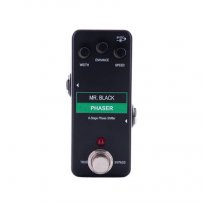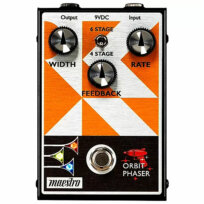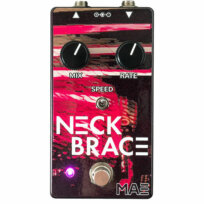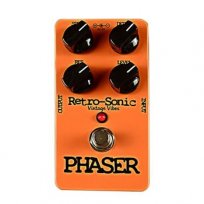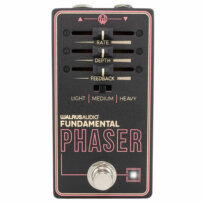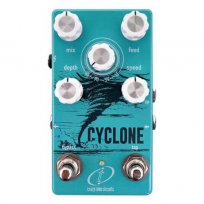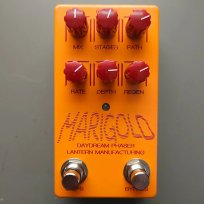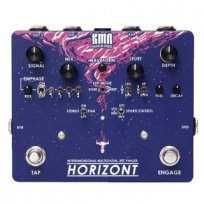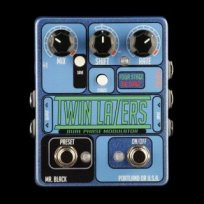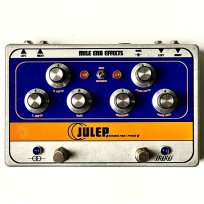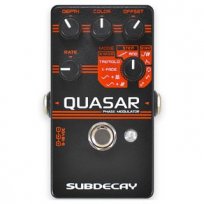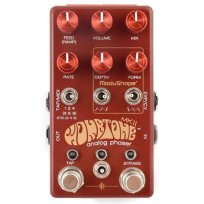
Welcome to our super-thorough buyer’s guide to the best phaser pedals, organized by features and price. You may also be interested in our separate articles about the best Uni-Vibe clones and variants – the two effects are very similar – or the one focused on multi-modulation pedals, most of which include a phaser mode.

What’s a Phaser?
Although most guitarists know how a phaser sounds (if you don’t, here’s an example for you) not everyone is aware that phasing, unlike reverb or echo, is an artificial sound that cannot be recreated naturally, even though “phase cancellation” is a natural sonic phenomenon used in other similar effects for guitar, like flanging and chorusing.
The phaser, instead, is an effect that uses an “all-pass filter” (which preserves the amplitude of the original signal but alters the phase) linked to an LFO to continuously and gradually change the phase of a source signal. This is then mixed back with the dry one, producing a cyclical swirly and swooshy sound due to ever-changing phase inconsistencies between the two signals.
Phasers were born in the ’70s as a variation on the Uni-Vibe, and the Maestro Phase Shifter PS-1A was the first effect to be named that way (although it was not a pedal yet!).
Phasing Stages, What Are They?
Each phaser circuit comes with a specific number of “stages.” That’s the number of all-pass filters employed by the circuit to create the phasing effect. The more the stages, the more the differences in phase (aka “notches”) between the affected and the dry signal we mentioned above, which, in theory, should create a more intense phasing effect, although other circuit variables affect each phaser’s final sound.
For an informed history of the phaser, we’ll delegate to everyone’s favorite pedal erudite Mr. JHS, and his video on the History of Phaser Pedals, below.

The Maestro Phase Shifter was the very first phaser (a tabletop device) and can be found used for around $500 on eBay or Reverb.com.
—
Best Phaser Pedals
As usual, rather than compiling an absolute list of our favorite phasers sporting completely different features one from the next, our approach to this shopping guide is based on the very relative question: “What are YOU looking for?”
The market is filled with simple phasers and advanced ones, traditional and creative ones, hosted in big or small cases; some of these are in mono and some in stereo and they all greatly vary in price. By bundling phaser pedals with similar features in separate categories, this article should help you identify the effect that fulfills your needs and budget.
• Best Classic Phaser Pedal (Under $130)
Phaser pedals aren’t complicated circuits and don’t necessarily require super expensive components; those of you looking for a classic-sounding yet no-frills effect don’t need to spend an arm and a leg to find a convincingly-sounding one. This “best budget phaser pedal” list highlights some of the best-selling analog phasers.
MXR Phase 90

$89 | Click title for video | Buy it on Sweetwater | Thomann | Amazon | Reverb
Launched in 1974, this 4-stage phaser was MXR’s first-ever pedal, which ended up becoming an iconic classic, inspiring and influencing a host of phaser circuits up to this day. One knob for speed and the rest is set. This is a reissue also referred to as “block logo” as opposed to the “script logo” version found in the original, compared to which it sounds a little deeper.
Our Thoughts: This is a sturdy device that marries simplicity with excellent tone. Its iconic sound, heard on countless records, feels instantly familiar and invites easy experimentation. Eddie Van Halen and David Gilmour have relied on this model, making it a reliable choice for recreating a classic phasing effect. With its affordability and efficiency, it offers an inexpensive route to achieving the same captivating sound found in many immortal records.
Pros: Classic, evergreen sound at an affordable price. | Cons: You can only change the LFO’s speed, everything else is set.
Here’s a list of other similar pedals in this category, organized by popularity:




—
• Best Mini Phaser Pedal
Mini pedals these days sound as good as their larger siblings, and sometimes they even come with extra features (like in the case of the Phase 95). With the added advantage of taking very little space on your board.
MXR Phaser 95

$99 | Click title for video | Buy it on Sweetwater | Thomann | Amazon | Reverb
The MXR Phase 95 gives you even more than the regular compact MXR phasers – in a mini case: the push button on the left gives you access to the phasing flavors of both the Phase 45 and Phase 90 circuits, while the Script switch on the right toggles between modern and vintage style phasing, voiced after MXR’s own versions of the Phase 90.
Our Thoughts: The four variations defy expectations, considering this is a mini pedal, and are a very welcome feature not found on the bigger Phase 90. They might produce subtle changes, but they can be important ones within signal chains involving other pedals like fuzz or other high-gain devices – the script Phase 45 mode, for example, sounds a lot more pleasing after a full-range fuzz than the classic block Phase 90, which works great on mid-scooped fuzz pedals like the Muff. At under $100 having this kind of versatility makes this pedal a no-brainer, in particular for those who don’t feel the need to tweak various settings like depth and intensity.
Pros: Four classic evergreen MXR phaser tones in a mini case, at an affordable price. | Cons: No controls other than speed.
Here’s a list of other similar pedals in this category, organized by popularity:



—
—
• Best Streamlined Boutique Phaser (above $130)
As is always the case in the pedalverse, some companies figure out ways to get next-level tone by using high-quality components, improved circuit design, and maximum attention to detail. This list includes boutique effects for the effect connoisseur that deliver the tone of the best vintage phaser pedals with lower noise, increased reliability, and – in some cases – a few extra features.
Jam Pedals The Ripple
Athens’ (the Greek one) Jam Pedals doesn’t do cheap components (they don’t even do OK components, for that matter…). The Ripple is a high-quality, simple yet popular one-knob homage to 2-stage phasing of the vintage MXR Phase 45 offering a unique, deep but not overwhelming “vibey” tone. It performs well before and after overdrive pedals.
Our Thoughts: Once again, a one-knob device makes it to the top of the list, and that can only mean one thing: it sounds great and it works well anywhere in your pedal chain, which is due to quality components and top-notch engineering.
Pros: A great-sounding recreation of an expensive vintage classic that does one thing and does it well. | Cons: With its lone Speed knob, this is not a pedal for tweakers.
Here’s a list of other similar pedals in this category, organized by popularity:


—
• Best Advanced Mono Phaser with Up to 4 Modes
The stompboxes in this category are all mono, high-quality, and boutique and include a few advanced features like multiple LFO waves, two or three modes with a varying number of phasing stages, and sometimes even dual phasing, tap tempo, and/or momentary effects. They come at a higher price point but deliver a wider palette of sonic possibilities.
Walrus Audio Lillian

$199 | Click title for video | Buy it on Zzounds, Sweetwater | Thomann | Amazon | Reverb
Based on the same concept as the Julia (the company’s popular chorus) and sharing the same number of controls, the Lillian features knobs for Rate, Width, and Feedback and a toggle switch to select between 6 or 4 stages. The bottom right D-P-V knob acts as an enhanced Mix control, producing tones that sound like a blend between dry, phase-shifted, and pitch vibrato.
Our Thoughts: This pedal strikes an excellent balance between intuitive controls and expanded sonic potential, in particular thanks to the D-P-V knob, which can deliver classic phaser tones but also venture into other modulation effects normally not covered by phasers.
Pros: Sounds great according to most people, and the controls allow for a variety of tones. | Cons: Some guitarists find it too subtle. No Tap Tempo.
Here’s a list of other similar pedals in this category, organized by popularity:


—
• Best Phaser Pedal with Stereo Out
The phaser was born as a mono effect, and so was the device it was inspired by – the rotary speaker. This being said, a stereo phaser will unavoidably sound better to most people than a mono one, because our ears love the depth of stereo. The pedals in this category are recommended for sound designers, producers, and those who can afford to play live with a stereo amp set up.
TC Eletronic Helix

$98 | Click title for video | Buy it on Sweetwater | Thomann | Amazon | Reverb
All the pedals listed in this category are excellent, but at around $100, the TC Helix represents a true deal for the stereo phaser seekers. It’s not only affordable but also super-flexible, with its two set modes (Vintage and Smooth) and an open slot for your favorite TonePrint, a proprietary system that allows the player to create new sounds through an app and transfer them to the pedal via USB. The four controls for Speed, Depth, Feedback and Mix cover all the basis, providing an ample palette of tones to work with.
Our Thoughts: Although the digital nature of this phaser delivers a tone that’s not as lush and organic as in the best analog units, the bang you get for under $100 is noteworthy, both tone- and feature-wise. Besides the full stereo path in a compact case, the flexibility and depth of editing granted by the TonePrint app is a true bonanza, making it hard not to find a tone that does the job, whatever the sonic circumstances – and the Helix happens to sound great even in applications where many analog phasers fail, like after a fuzz pedal.
Pros: Great price and the infinite flexibility of TonePrint. | Cons: No Tap Tempo. Some guitarists find the Mix knob a little inconsistent.
Here’s a list of other similar pedals in this category, organized by popularity:
—
• Best Phaser Pedal with 5 or More Modes
The pedals in this list, rather than overwhelming you with controls, give you just a few knobs but several pre-set modes, including phasers with a varying number of phasing stages and creative variations on the theme like step, envelope and/or unidirectional phasing.
BOSS Phase Shifter PH-3

$147 | Click title for video | Buy it on Sweetwater | Thomann | Amazon | Reverb
One of the best-selling phasers ever, the BOSS PH-3 is a 7-mode phaser with tap tempo and simple controls offering classic-sounding 4, 8, 10 and 12-stage effects but also “Fall” and “Rise” modes (creating unidirectional phasing) and a “Step” mode which randomizes the LFO in steps synched to the tempo. The rate can be controlled through an Expression pedal. The three knobs allow to fine-tune Rate, Depth and Resonance. Previous versions, the PH-2 Super Phaser and the recently reissued PH-1 Phaser are still popular in the used market.
Our Thoughts: This is a digital pedal that succeeds at giving you both the bread-and-butter phaser tones in all their more subtle variations and some interesting innovative modes. Some modes are voiced after classic one-knob phasers (read, the orange MXR line) but allow for extra tweaking compared to the original, thanks to the Depth and Resonance controls. The lack of a Wet/Dry knob is a little disappointing, but none of the vintage phasers had it anyway. What we also like about the PH-3 is that it’s one of the few phasers that let you choose the number of stages, which is not only cool but also educational – although it misses a 2-step mode.
Pros: Lots of classic and innovative phasing effects. | Cons: It slightly dampens the signal’s volume when on, no LFO waves nor Wet/Dry knob.
Here’s a list of other similar pedals in this category, organized by popularity:
—
• Best Super-Tweakable Phaser Pedal
This is a list that includes devices filled with knobs and switches that give the player the ability to recreate a wide variety of phaser effects, with varying phasing stages, waveforms and sonic characters, and often also dual phaser interaction.
Strymon Zelzah

$349 | Click title for video | Buy it on Sweetwater | Thomann | Amazon | Reverb
Strymon was able to create something truly special with this studio-quality, dual, stereo phaser delivering a staggering amount of flexibility. It features a 3-mode, 4-stage vintage-style circuit on the left side and a more modern 6-stage phaser with controllable resonance on the right. The voice knob controls simultaneously over 30 parameters and can deliver also flanger and chorus effects. The left channel has an Envelope mode that works like an auto-wah, while Barber mode delivers a continuously rising sweep. When fed into each other, the two phasers combine to create complex interactive phasing (stereo) textures. Each control has a secondary function accessible by holding the respective side’s footswitch.
Our Thoughts: As true phaser lovers, we found not only an encyclopedia of tones in this purple box but also a range of unexpected effects from the otherworldy to the extreme. The Zelzah can do both classic and wild phaser tones, using single or dual phasing when compounding the two channels, which can produce inspiring, subtle texture or exciting and unusual sounds.
Pros: Incredibly flexible, it can do anything phaser-related and do it well. | Cons: pricey, lacks LFO waveforms, presets, and onboard tap tempo.
Here’s a list of other similar pedals in this category, organized by popularity:

—
• Best Creative/Unusual Phaser Pedal
Circuits that approach traditional effects from a new angle are fun and inspiring, and that’s what the pedals in this list do. Most of these “weird” phaser pedals can still deliver the classic phaser sound, but what they do best is take the effect’s possibilities to a new level, often producing intriguing otherworldly results.
Old Blood Noise Dweller

$199 | Click title for video | Buy it on Perfect Circuit | Thomann | Amazon | Reverb
Not your “regular Joe” circuit, the Old Blood Noise Dweller is a unique “phase repeater” with a time stretching circuit that changes the delay time inside each phaser stage, delivering anything from familiar phase and vibe sounds to resonant random step filtering and warm delays. The two phaser voices (4-stage and 8-stage) and three wave shapes (sine, triangle, and random step) are controlled via Rate, Depth, Regen and Mix knobs.
Our Thoughts: Some pedals are inspiring because of they do something that’s unexpectedly beautiful, and this pedal belongs to that category. This is a very pleasant-sounding device that does phasing but a lot more than that. It was created with ambient and textural guitarists in mind – so not really for those into Classic Rock – but that’s totally up to our ally.
Pros: fun, unique, and inspiring. | Cons: not for everyone.
Here’s a list of other similar pedals in this category, organized by popularity:

—
• Best Phaser + Tremolo Pedals
The phaser + tremolo combo seems to be an inspiring one for boutique pedal builders. While researching pedals for this article, we unexpectedly found these devices that belong to this unusual category, and they all sound from interesting to great!
Pigtronix Moon Pool
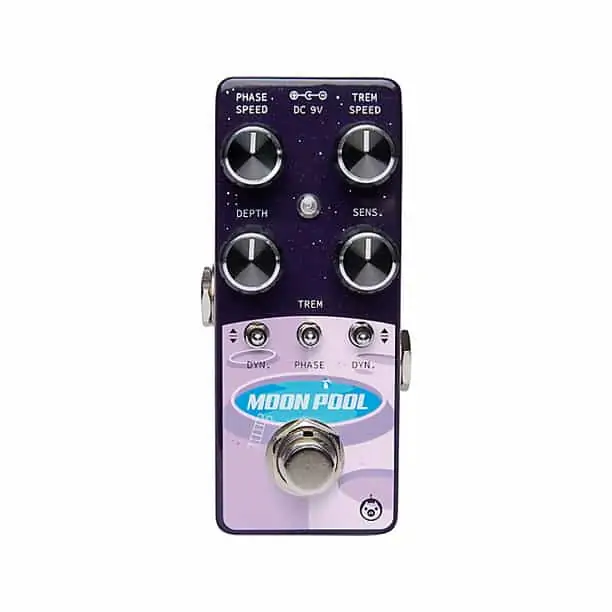
$179 | Click title for video | Buy it on Sweetwater | Thomann | Amazon | Reverb
The Pigtronix Moon Pool is a mini, analog 4-stage phase shifter and bias tremolo with a surprising number of controls, for such a little guy. Each effect has independent speed knobs and a shared one for Depth, and each can be run in LFO or envelope mode, the latter being adjusted via the Sens(itivity) knob that allows setting the envelop’s attack threshold. The 3-way toggle switch in the center lets you run the two effects separately or, when set in the center position, together.
Pros: a uniquely creative mini pedal with lots of features. | Cons: a little pricey, no separate depth control.
Here’s a list of other similar pedals in this category, organized by popularity:
—
• Noteworthy Discontinued Phasers


—
Phaser Pedals Shootout Videos
MXR Phase 90 vs EHX Small Stone
Comparing 7 Affordable Phaser Pedals
—























